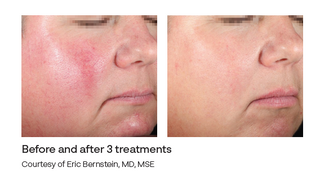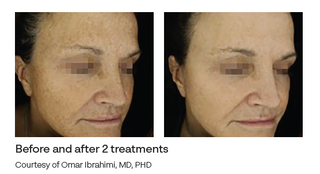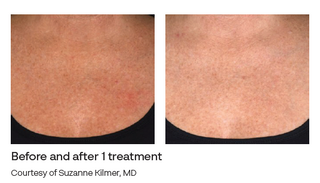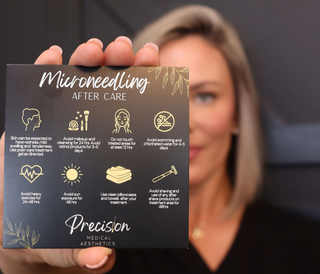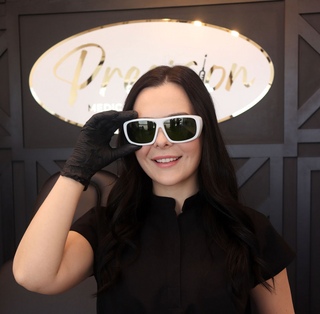
DERMAV LASER
KEY PURPOSE
The DermaV laser is primarily used for vascular treatments and improving skin texture, particularly targeting a range of skin concerns related to blood vessels. It helps to treat: vascular lesions, provides skin rejuvenation & reduces redness.
longevity
The longevity of DermaV laser treatments depends on the skin concern, but with proper care and maintenance, results can last for a significant amount of time.
APPOINTMENT TIME
Average appointment time is 40 minutes.
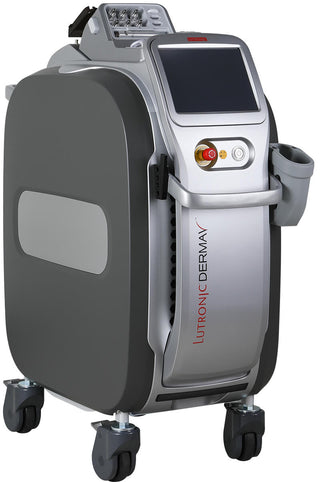
WHAT IS THE DERMAV LASER?
The DermaV laser is primarily used for vascular treatments and improving skin texture, particularly targeting a range of skin concerns related to blood vessels. It is a 532 KTP laser and NdYag 1064nm which means it uses a specific wavelength of light to target and treat blood vessels beneath the skin's surface. Some of the most common uses of the DermaV laser include:
1. Treatment of Vascular Lesions:
- Spider veins and varicose veins: The laser is effective for reducing the appearance of small to medium-sized veins, including spider veins on the face and legs.
- Rosacea: DermaV helps treat the redness, flushing, and visible blood vessels associated with rosacea by targeting and shrinking the dilated blood vessels.
- Hemangiomas: These are benign tumors made up of blood vessels that can appear as red or purple spots on the skin. The DermaV laser can reduce their size and appearance.
- Port-wine stains: These are birthmarks caused by abnormal blood vessels, and the laser can help lighten or remove them.
2. Skin Rejuvenation:
- Skin tone and texture: The DermaV laser can also be used for improving the overall tone and texture of the skin, by stimulating collagen production. This helps with fine lines, wrinkles, and general skin elasticity.
3. Reducing Redness:
- The laser can target areas of redness in the skin caused by sun damage, acne scarring, or irritation. This makes it useful for treating skin discoloration or uneven skin tone.
4. Non-Ablative Treatment:
- DermaV is a non-ablative laser, meaning it does not remove or damage the top layers of skin. This makes the procedure less invasive with a faster recovery time compared to more aggressive treatments.
HOW DOES DERMAV WORK?
The laser emits a pulsed light that is absorbed by the blood vessels, causing them to coagulate and eventually break down. The body's natural healing processes then absorb the treated vessels, resulting in improved appearance and skin tone.
Key Benefits:
- Minimal downtime: Most people can return to normal activities immediately after treatment.
- Precise targeting: It selectively targets blood vessels without affecting the surrounding skin.
- Safe for all skin types: The DermaV laser is effective across a wide range of skin tones, making it versatile.
In summary, the DermaV laser is a versatile treatment option for addressing vascular skin conditions, improving skin tone, and enhancing overall skin appearance with minimal downtime.
FAQ'S
DERMA V TREATMENT MENU
CHERRY ANGIOMA OR SINGLE SPOT
$150 + HST PER TREATMENT
PIGMENT TREATMENT
$250.00 + HST PER TREATMENT
ROSACEA & FACIAL VESSELS TREATMENT
$350+HST PER TREATMENT
OR $900+HST FOR PACKAGE OF 3
SPIDER VEINS ON FACE
$150+HST PER TREATMENT
SPIDER VEINS/
TELENGECTASIA OF CHEST
$150+HST PER TREATMENT
PRE TREATMENT CARE
2-4 WEEKS PRIOR
Avoid sun exposure, tanning beds, and self tanners 4 weeks prior to treatment.
A few days before your treatment avoid skin irritants such as;
- Products containing tretinoin, retinol, benzoyl peroxide, glycolic/salicylic acids, vitamin C/ascorbic acid, astringents, etc.
DAY OF TREATMENT
Skin must be clean and free of makeup, lotions, oils, serums, etc. Make sure area is hair free prior to your appointment (possible reduction).
POST TREATMENT CARE
1. Protect Your Skin from the Sun
- Avoid direct sun exposure for at least 2 weeks after your treatment. The skin will be more sensitive, and sun exposure can cause pigmentation issues or damage to the treated area.
- Use broad-spectrum sunscreen (SPF 30 or higher) every day, even if you’re indoors or on cloudy days. This is especially important in the days and weeks following the treatment to protect your skin and maintain results.
2. Avoid Heat and Hot Water
- Avoid hot showers, baths, or saunas for at least 48 hours after treatment, as heat can irritate the skin and exacerbate swelling or redness.
- No strenuous exercise for 24-48 hours, as sweating and increased blood flow may irritate the treated areas and cause discomfort or potential complications.
3. Moisturize Regularly
- After treatment, your skin may feel dry or tight. Use a gentle, hydrating moisturizer to keep the skin nourished and promote healing. Look for moisturizers with soothing ingredients like aloe vera or hyaluronic acid.
- Avoid moisturizers with fragrances, alcohol, or other harsh chemicals that could irritate the skin.
4. Avoid Exfoliating or Scrubbing
- Do not exfoliate, scrub, or use harsh facial cleansers for at least 7-10 days post-treatment. This includes avoiding physical scrubs, chemical exfoliants (like AHAs or BHAs), or products with retinoids.
- Be gentle when cleansing your face, using a mild, non-abrasive cleanser and lukewarm water.
5. No Makeup Immediately After
- Avoid makeup on the treated area for 24-48 hours after the treatment, as the skin may be more sensitive, and makeup can introduce bacteria that may cause irritation or breakouts.
- After this initial period, you can return to your normal makeup routine, but it’s best to use products that are non-comedogenic and gentle on the skin.
6. Don’t Touch, Scratch, or Pick the Treated Area
- Avoid touching, scratching, or picking at the treatment area, especially if you notice any crusting, swelling, or bumps. Picking can introduce bacteria and increase the risk of infection or scarring.
- If you feel any itching or discomfort, use a soothing cream or ointment recommended by your provider.
7. Expect Some Redness and Swelling
- Mild redness and swelling are common immediately after the procedure and can last anywhere from a few hours to a few days.
- If you experience bruising or temporary raised bumps, don’t be alarmed—this is normal and usually resolves within a week. If these side effects persist or worsen, contact your provider for advice.
8. Avoid Blood Thinners
- For 2-3 days after treatment, try to avoid medications or supplements that could thin the blood (such as aspirin, ibuprofen, or fish oil), as they may increase the risk of bruising.
9. Be Aware of Lumps or Bumps
- Temporary lumps or bumps may form where the blood vessels were treated. This is a normal reaction to the laser and will typically subside within a few weeks. Avoid massaging or pressing on these areas.
10. Follow-Up Appointments
- Your provider may schedule a follow-up appointment to check on your progress, typically within 4-6 weeksafter your treatment.
- During the follow-up, they will assess how well the treatment worked and determine if any additional sessions are needed to achieve the desired results.

